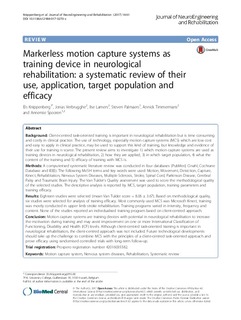| dc.contributor.author | Knippenberg, Els | |
| dc.contributor.author | Verbrugghe, Jonas | |
| dc.contributor.author | Lamers, Ilse | |
| dc.contributor.author | Palmaers, Steven | |
| dc.contributor.author | Timmermans, Annick | |
| dc.contributor.author | Spooren, Annemie | |
| dc.date.accessioned | 2019-02-28T20:01:53Z | |
| dc.date.available | 2019-02-28T20:01:53Z | |
| dc.date.issued | 2017 | |
| dc.identifier.citation | Knippenberg, E., Verbrugghe, J., Lamers, I., Palmaers, S., Timmermans, A., & Spooren, A. (2017). Markerless motion capture systems as training device in neurological rehabilitation: a systematic review of their use, application, target population and efficacy. Journal of NeuroEngineering and Rehabilitation, 14(1), 61. | |
| dc.identifier.uri | http://hdl.handle.net/11250/2588142 | |
| dc.description.abstract | Background
Client-centred task-oriented training is important in neurological rehabilitation but is time consuming and costly in clinical practice. The use of technology, especially motion capture systems (MCS) which are low cost and easy to apply in clinical practice, may be used to support this kind of training, but knowledge and evidence of their use for training is scarce. The present review aims to investigate 1) which motion capture systems are used as training devices in neurological rehabilitation, 2) how they are applied, 3) in which target population, 4) what the content of the training and 5) efficacy of training with MCS is.
Methods
A computerised systematic literature review was conducted in four databases (PubMed, Cinahl, Cochrane Database and IEEE). The following MeSH terms and key words were used: Motion, Movement, Detection, Capture, Kinect, Rehabilitation, Nervous System Diseases, Multiple Sclerosis, Stroke, Spinal Cord, Parkinson Disease, Cerebral Palsy and Traumatic Brain Injury. The Van Tulder’s Quality assessment was used to score the methodological quality of the selected studies. The descriptive analysis is reported by MCS, target population, training parameters and training efficacy.
Results
Eighteen studies were selected (mean Van Tulder score = 8.06 ± 3.67). Based on methodological quality, six studies were selected for analysis of training efficacy. Most commonly used MCS was Microsoft Kinect, training was mostly conducted in upper limb stroke rehabilitation. Training programs varied in intensity, frequency and content. None of the studies reported an individualised training program based on client-centred approach.
Conclusion
Motion capture systems are training devices with potential in neurological rehabilitation to increase the motivation during training and may assist improvement on one or more International Classification of Functioning, Disability and Health (ICF) levels. Although client-centred task-oriented training is important in neurological rehabilitation, the client-centred approach was not included. Future technological developments should take up the challenge to combine MCS with the principles of a client-centred task-oriented approach and prove efficacy using randomised controlled trials with long-term follow-up. | nb_NO |
| dc.publisher | Journal of NeuroEngineering and Rehabilitation | nb_NO |
| dc.rights | Navngivelse 4.0 Internasjonal | * |
| dc.rights.uri | http://creativecommons.org/licenses/by/4.0/deed.no | * |
| dc.subject | motion capture system | nb_NO |
| dc.subject | nervous system diseases | nb_NO |
| dc.subject | rehabilitation | nb_NO |
| dc.subject | systematic review | nb_NO |
| dc.title | Markerless motion capture systems as training device in neurological rehabilitation: a systematic review of their use, application, target population and efficacy | nb_NO |
| dc.type | Journal article | nb_NO |
| dc.source.volume | 14 | nb_NO |
| dc.source.journal | Journal of NeuroEngineering and Rehabilitation | nb_NO |
| dc.source.issue | 61 | nb_NO |
| dc.identifier.doi | https://doi.org/10.1186/s12984-017-0270-x | |

